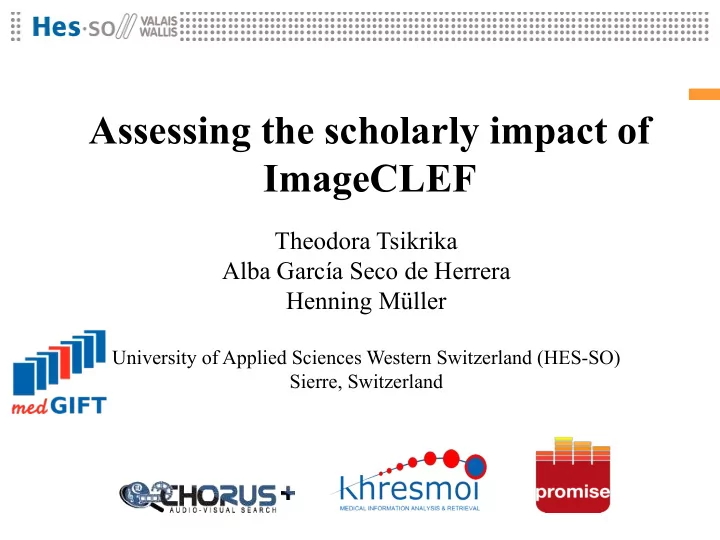

Assessing the scholarly impact of ImageCLEF Theodora Tsikrika Alba García Seco de Herrera Henning Müller University of Applied Sciences Western Switzerland (HES-SO) Sierre, Switzerland CLEF 2011, Sept 21, 2011 1
Evaluation campaigns Enable the reproducible and comparative evaluation through the use of standardised resources and common evaluation methodologies • Benefits: • Provide access to evaluation infrastructure • Build reusable resources for benchmarking • Promote exchange of ideas • Encourage collaboration and interaction • Resulting in: • Development of new approaches • Increased quality of evaluation methodologies • Advancement of the field CLEF 2011, Sept 21, 2011 2
Evaluation campaigns: assessing impact? Assess the impact of the research they foster • research that would otherwise not have been possible • Scientific impact: • Scholarly impact, filed patents, … • Economic impact: • Technology transfer, time & effort saved for researchers, … CLEF 2011, Sept 21, 2011 3
Evaluation campaigns: impact assessment B. R. Rowe, D. W. Wood, A. N. Link, and D. A. Simoni. Economic impact assessment of NIST’s Text REtrieval Conference (TREC) Program . Technical Report, Project Number 0211875, RTI International, 2010. C. V. Thornley, A. C. Johnson, A. F. Smeaton, and H. Lee. The scholarly impact of TRECVid (2003–2009) . JASIST, 62(4):613–627, 2011. CLEF 2011, Sept 21, 2011 4
Objectives • Assess the scholarly impact of ImageCLEF • Compare different methods in performing such an assessment CLEF 2011, Sept 21, 2011 5
ImageCLEF: cross-language image retrieval CLEF 2011, Sept 21, 2011 6 6
Assessing the scholarly impact • Perform bibliometric analysis • Obtain derived publications and their citations • Calculate metrics (e.g., h-index) • Sources for publication and citation data • Thomson Reuters (ISI) Web of Science ● Scopus ● Google Scholar 7
Comparison of data sources and tools • Thomson Reuters (ISI) Web of Science + Coverage of more than 10,000 journals − Very limited coverage of conference proceedings + High-quality citation data + Provides metrics • Scopus + Coverage of more than 18,000 titles + Includes many conference proceedings − Citation coverage only after 1996 + High-quality citation data + Provides metrics • Google Scholar + Wider coverage that includes additional journals and conference proceedings, plus books, technical reports, white papers, etc. − Errors in citation data − Does not provide metrics + … but Publish or Perish (PoP) does CLEF 2011, Sept 21, 2011 8 8
Comparison of data sources and tools • Thomson Reuters (ISI) Web of Science + Coverage of more than 10,000 journals − Very limited coverage of conference proceedings + High-quality citation data + Provides metrics • Scopus + Coverage of more than 18,000 titles + Includes many conference proceedings − Citation coverage only after 1996 + High-quality citation data + Provides metrics • Google Scholar + Wider coverage that includes additional journals and conference proceedings, plus books, technical reports, white papers, etc. − Errors in citation data − Does not provide metrics + … but Publish or Perish (PoP) does CLEF 2011, Sept 21, 2011 9 9
Google Scholar shortcomings • Several entries for the same publication • Due to mispellings • May deflate citation count • PoP allows manual merging of publications • Grouping citations of different papers • With similar titles and author lists • E.g., conference and journal versions of a paper • Manual data cleaning • Inability to correctly identify publication year 10
Dataset of ImageCLEF publications • ImageCLEF papers in CLEF working notes • not indexed by Scopus ● ImageCLEF papers in CLEF proceedings ● published in the year following the workshop ● Papers describing ImageCLEF resources published elsewhere • written by ImageCLEF organisers • Papers using ImageCLEF resources pubished elsewhere • written by groups that have participated or just registered without submitting runs or acquired the data at a later stage 11
Dataset of ImageCLEF publications • ImageCLEF papers in CLEF working notes • not indexed by Scopus ● ImageCLEF papers in CLEF proceedings ● published in the year following the workshop ● Papers describing ImageCLEF resources published elsewhere • written by ImageCLEF organisers • Papers using ImageCLEF resources pubished elsewhere • written by groups that have participated or just registered without submitting runs or acquired the data at a later stage 12
ImageCLEF publications and citations ● ~ 70% of citations are from papers not in CLEF proceedings ● 8.62 cites per paper on average 13
Overview vs. Participants’ papers CLEF proceedings All (CLEF proceedings + ImageCLEF resources) 90% of the papers that have # citations ≥ h-index are overviews CLEF 2011, Sept 21, 2011 14
The 2005 overview paper Single overview for both medical and general image tasks Half life of approximately three years CLEF 2011, Sept 21, 2011 15
General vs. Medical image annotation and retrieval Publications in medical domain have slightly higher impact 16
General vs. Medical image annotation and retrieval Scopus PoP publications citations ● 2006-2008 publications in medical domain have high impact CLEF 2011, Sept 21, 2011 17 17
Citations per task • Peak in second or third year of operation • Followed by a decline • … unless there is a major overhaul of the task • Tasks with greatest impact – Photographic retrieval – Medical image retrieval – Medical annotation CLEF 2011, Sept 21, 2011 18 18
Conclusions and Future Work • Preliminary analysis shows important impact of ImageCLEF • 249 publications • 303 citations in Scopus • 2,147 in Google Scholar • Scopus vs. Google Scholar • Both have advantages and limitations • Next steps: • Automate process (as much as possible) • Include working notes (~ 500 papers in total) • Include ImageCLEF derived papers (~1,000 papers in total) • Perform analysis for the whole CLEF CLEF 2011, Sept 21, 2011 19
Recommend
More recommend